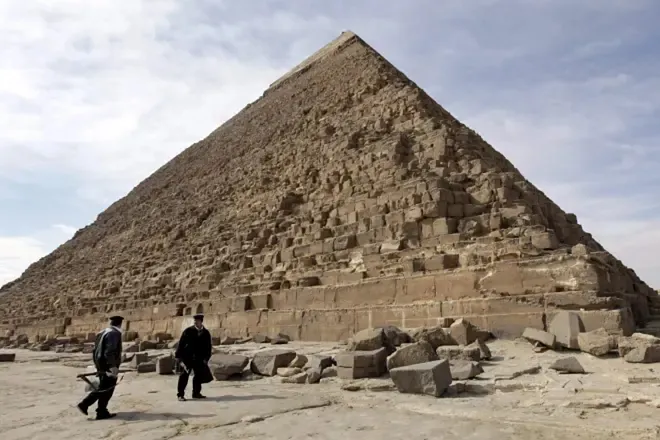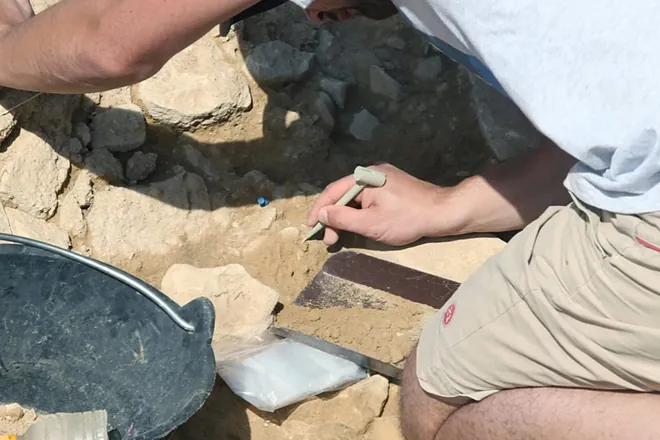The pyramids of Egypt have fascinated people for centuries. These massive structures, especially the Step Pyramid of Djoser and the Great Pyramid of Giza, are marvels of ancient engineering. For years, archaeologists believed the pyramids were built using ramps, levers, and sheer human effort. But a new study suggests something incredible: the ancient Egyptians might have used water-powered machines to lift heavy stones.

The Traditional View: How Were the Pyramids Built?
For a long time, historians and archaeologists thought the pyramids were built with ramps and human labor. The Great Pyramid of Giza, built around 2600 BCE, is made of millions of limestone blocks, some weighing over 2.5 tons. Experts believed workers dragged these stones up ramps—long, sloping paths made of mudbrick or sand—to place them in the pyramid. Evidence like workers’ cemeteries, tools, and inscriptions near the pyramids supports this idea. Thousands of laborers, including skilled workers and possibly volunteers, worked together, supported by food and housing.
Other theories suggested levers, pulleys, or rolling stones on logs, but ramps have been the most accepted method. At some pyramid sites, archaeologists found ramp remnants, making this theory solid. But building a pyramid this way required immense effort and organization. Could there have been a smarter, less labor-intensive method? A new study says yes.
A Game-Changing Idea: Water-Powered Pyramid Construction
In August 2024, a study published in PLOS ONE by Xavier Landreau and his team at the Paleotechnic Institute in France proposed a bold idea: the Step Pyramid of Djoser, built around 2680 BCE, may have used a hydraulic system to lift stones. This water-powered machine could have worked like an elevator, raising heavy limestone blocks with less effort than ramps. The idea challenges everything we thought we knew about pyramid construction. Let’s break down how it might have worked.
The Hydraulic System: How Did It Work?
The researchers suggest the ancient Egyptians used water to create a hydraulic lift system. Here’s the basic idea:
- Capturing Water with a Dam: Near the Step Pyramid in Saqqara, there’s a massive stone structure called Gisr el-Mudir. Previously thought to be ceremonial, it might have been a check dam. This dam could have caught floodwaters from the nearby Abusir Wadi, storing millions of gallons of water—enough to power a construction system.
- Cleaning the Water: Surrounding the Djoser complex is a feature called the Dry Moat. The study suggests it acted like a water treatment plant. Its stepped basins could have filtered out dirt and sediment, ensuring clean water for the hydraulic system. This setup is similar to modern water treatment facilities.
- Lifting Stones with Water: Inside the Step Pyramid, there are two vertical shafts connected by a long underground tunnel. The researchers propose that water was poured into one shaft to lift a float or platform carrying a stone block. By controlling the water flow, workers could raise and lower the platform, moving stones up the pyramid’s center in a “volcano-style” construction. This method would have been precise and efficient.
- Water Source: The system likely used seasonal Nile River floods or a now-extinct waterway called the Ahramat Branch, discovered in 2024 using satellite imagery. This branch brought water close to the Saqqara Plateau, making the hydraulic system possible.
This setup shows the Egyptians’ deep understanding of water management, which they already used for irrigation and transporting materials by barge. If true, it means they applied this knowledge to build one of the world’s earliest stone monuments.
Evidence for the Hydraulic Hypothesis
The idea of water-powered machines sounds futuristic, but there’s evidence to back it up:
- Archaeological Clues: The Gisr el-Mudir, Dry Moat, and internal shafts in the Step Pyramid are arranged in a way that fits a hydraulic system. Granite pieces in the tunnels, once thought to be part of a tomb, might have been valves or seals to control water flow.
- Water Management Expertise: The Egyptians were experts at managing water. They built canals and used Nile floods for farming and transport. A hydraulic lift would be a natural extension of this skill.
- Topography Support: Satellite images and studies of the Saqqara landscape show watercourses from the Abusir Wadi could have reached the pyramid site. The Dry Moat’s basins align with water-cleaning functions.
- Computer Models: Simulations suggest water pressure in the shafts could lift blocks weighing up to seven tons, supporting the idea of a hydraulic elevator.
These findings paint a picture of a highly advanced civilization that could have used water as a tool to build massive structures.
Why Some Experts Are Skeptical
While the hydraulic hypothesis is exciting, not everyone is convinced. Here are some reasons why:
- Limited Water Supply: Critics like archaeologist Oren Siegel point out that the Saqqara region is a desert with little rain—less than two inches a year. The Gisr el-Mudir dam might not have held enough water year-round, especially without a permanent lake nearby.
- No Direct Proof: No remains of floats, platforms, or specific hydraulic tools have been found. The shafts and tunnels could have had other uses, like ventilation or ceremonial purposes.
- Smaller Blocks: The Step Pyramid’s blocks, averaging 300 kg, were smaller than the Great Pyramid’s 2.5-ton stones. These lighter blocks could have been moved with ramps or sledges, making a complex hydraulic system less necessary.
- Lack of Texts: Ancient Egyptian records, like temple reliefs, don’t mention water-powered lifts. This silence raises doubts, as the Egyptians often documented their achievements.
- Study Limitations: Some archaeologists note that the research team didn’t include Egyptologists, and the study questions whether the Step Pyramid was a tomb, which clashes with mainstream views.
These challenges mean the hypothesis needs more evidence, like physical traces of water flow or detailed studies of the moat and shafts.
What This Means for Ancient Egyptian Engineering
If the hydraulic theory is correct, it changes how we see ancient Egyptian technology. It suggests they had advanced engineering skills centuries earlier than previously thought. The system would have made construction faster and less labor-intensive, showing their ability to solve complex problems with the resources around them—like turning desert floods into a construction tool.
This idea doesn’t mean ramps weren’t used. Instead, the Egyptians might have combined methods: hydraulics for lifting stones vertically and ramps for final placement. The Step Pyramid’s unique design, with no clear burial remains, also hints it might have served a practical purpose beyond a tomb, though this idea is controversial.
Could Other Pyramids Have Used Water Power?
The hydraulic hypothesis focuses on the Step Pyramid, but could it apply to others, like the Great Pyramid of Giza? The discovery of the Ahramat Branch, a Nile waterway near Giza, suggests water was key for transporting stones to pyramid sites. Researchers are now exploring whether similar hydraulic systems existed elsewhere. The Great Pyramid’s larger blocks would have been harder to lift with water, but the idea can’t be ruled out without further study.
Public Reaction and Future Research
The idea of water-powered pyramids has sparked excitement online. On platforms like X, people call it a “game-changer” that debunks wild theories like aliens building the pyramids. Others are skeptical, asking why such a discovery hasn’t been bigger news or whether modern engineers could recreate the system. Academics are calling for more research, like drilling into the Dry Moat for sediment evidence or analyzing the shafts for water flow traces.
Future studies could confirm or debunk this theory. If proven, it would rewrite history books, showing the Egyptians as hydraulic pioneers. Even if it’s not fully correct, it pushes us to rethink their ingenuity.
Why This Matters Today
The pyramids have always symbolized human potential. This new hypothesis reminds us that ancient people solved massive challenges with creativity and skill. It also shows how archaeology keeps evolving, using tools like satellite imagery and computer modeling to uncover secrets hidden for millennia. Whether the Egyptians used water power or not, their achievements inspire us to push the limits of what’s possible.
Want to Learn More?
If you’re curious about the pyramids or ancient engineering, here are some ways to dive deeper:
- Read the Study: Check out the PLOS ONE article for technical details.
- Explore Saqqara: Look up virtual tours of the Step Pyramid and its surroundings.
- Follow Archaeology News: Stay updated on new discoveries about ancient Egypt.
- Visit Museums: Many museums, like the Cairo Museum, have exhibits on pyramid construction.
The pyramids still hold mysteries, and each discovery brings us closer to understanding the genius of the ancient Egyptians. What do you think about this water-powered theory? Let me know in the comments!






